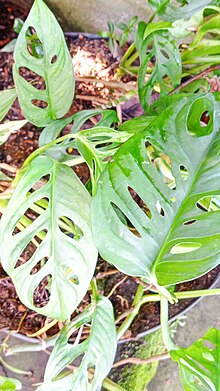
Summary
Monstera adansonii, the Adanson's monstera,[2] Swiss cheese plant,[3] or five holes plant, is a species of flowering plant from family Araceae which is widespread across much of South America and Central America.[4] Monstera adansonii is classified as a hemi-epiphyte vine and can be found in tropical forest with hot and high humidity conditions.[5] Other regions this plant may be found in are the West Indies, Antigua, Grenada, Saba, St. Kitts, Guadeloupe, Marie Galante, Dominica, Martinique, St. Lucia, St. Vincent, Tobago, and Trinidad. Currently, there are three recognized subspecies of Monstera adansonii, the M. adansonii subsp. blanchetii, M. adansonii subsp. klotzschiana and M. praetermissa.species. A fourth subspecies has been proposed recently, the M. adansonii subsp. laniatais, distinguishable by the number of leaf fenestrations and the angle of the fenestrations. [6] The species are quite common near river valleys at lower elevations.[7]
| Monstera adansonii | |
|---|---|

| |
| Scientific classification | |
| Kingdom: | Plantae |
| Clade: | Tracheophytes |
| Clade: | Angiosperms |
| Clade: | Monocots |
| Order: | Alismatales |
| Family: | Araceae |
| Genus: | Monstera |
| Species: | M. adansonii
|
| Binomial name | |
| Monstera adansonii | |
| Synonyms[1] | |
| |
The common name "Swiss cheese plant" is also used for the closely related species Monstera deliciosa.[3]
Description edit
Monstera adansonii is known for its beautiful heart-shaped leaves. The leaves have a somewhat thick, waxy texture, and contain large oval-shaped perforations, which lead to its common name of "swiss cheese plant". It grows to be 3–5 feet tall as a houseplant and up to 13 feet as a vine. The Adanson's monstera is an easy to care for houseplant, that likes bright indirect sunlight and well draining soil.[8] [9] There are some cultivars with variegated leaves, including 'Archipelago'.[10]
References edit
- ^ "Monstera adansonii - Costela-de-adão". Flora SBS. Retrieved June 4, 2013.
- ^ USDA, NRCS (n.d.). "Monstera adansonii". The PLANTS Database (plants.usda.gov). Greensboro, North Carolina: National Plant Data Team. Retrieved 13 July 2015.
- ^ a b Wiersema, John H.; León, Blanca (2016). World Economic Plants: A Standard Reference (2nd ed.). CRC Press. p. 452. ISBN 9781466576810 – via Google Books.
- ^ "Monstera adansonii Schott". University of Connecticut. Retrieved June 4, 2013.
- ^ "A Preliminary Study of Genetic Variation in Populations of Monstera adansonii var. klotzschiana (Araceae) from North-East Brazil, Estimated with AFLP Molecular Markers I. M. Andrade, S. J. Mayo, C. van den Berg, M. F. Fay, M. Chester, C. Lexer, D. Kirkup".
- ^ "A morphometric and taxonomic study of Monstera (Araceae) in Bahia, Brazil Mayo, S.J. and Andrade, I.M."
- ^ "Monstera adansonii Schott, Wiener Z. Kunst". pp. 1028–1830.
- ^ "Monstera Adansonii: The Magnificent Monkey Mask Plant". Epic Gardening. 2020-02-08. Retrieved 2021-08-23.
- ^ Jyoti, Asha (10 August 2021). "How to take care of monstera adansonii". Foodthesis. Retrieved 9 June 2023.
- ^ "Variegated Monstera Adansonii Archipelago [ Complete Care Guide ]". Gasworks Flora. Retrieved 12 February 2022.
Media related to Monstera adansonii at Wikimedia Commons


